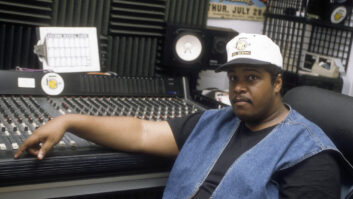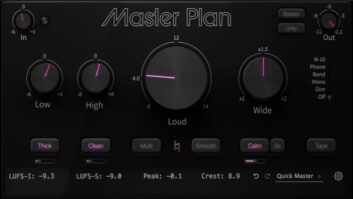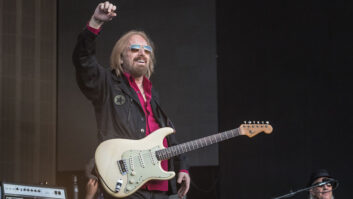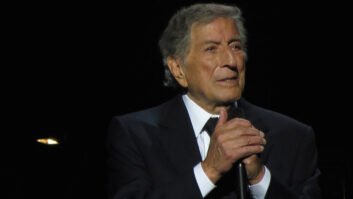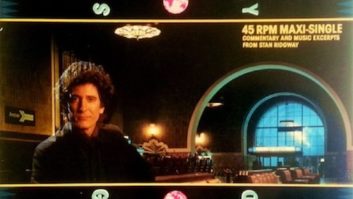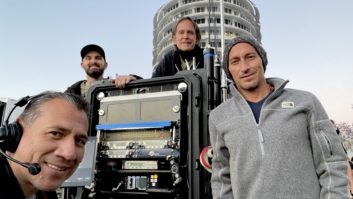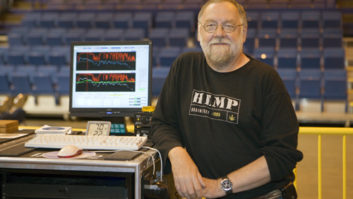Lunching with Bonzai:

Stan Freberg and his son Donavan.
Photo by Mr. Bonzai
Stan Freberg—Just the Tip of the Freberg
This interview with the remarkable Stan Freberg, from the Lunching With Bonzai series of 167 interviews, first appeared in Mix magazine in 1983.
“I was a very quiet and introverted child, like my friend Ray Bradbury. We had very similar parallels in childhood. We are now helping to design an indoor theme park for the Six Flags people in Baltimore.” Think of it. Stan Freberg and Ray Bradbury creating an amusement park! Humor and science fiction might be just the E-ticket to save the human race.
I met Stan Freberg not because I recognized his face, but because I overheard his voice in a crowded L.A. supermarket. I did a mental double-take, looked around and pushed my way through the shopping carts to shake this man’s hand. He cordially introduced his 12-year-old son, Donavan, and we made plans for a lunching. I thought it would be revealing fun to meet with two generations of Frebergs.
The first week that we tried to meet was taken up with cancellations due to his work on some Jeno’s Pizza commercials. The next week was interrupted by a sudden need to transport his props and archives from a warehouse that was being torn down. He told me that he was having trouble getting an eight-foot rubber pizza into his basement. I also learned that he was getting flack from The Magic Castle, an unusual L.A. nightclub, because he was storing the 12-foot soup can from the Heinz “Great American Soup” commercials in their garage. “It’s getting a little dented from the busboys squeezing by,” he told me.
It was altogether appropriate that I met Stan Freberg because of his auditory presence. His imaginative use of character voices, sound effects and unlimited music have forever altered the course of popular audio. Those of you who have followed his career as a distinctive musical satirist and the man who created an unmatched success in humorous advertising would be tickled to tour his home in Beverly Hills. He lives in an eccentric sanctuary: a villa filled with elegant 16th century Spanish antiques, an occasional plumbing problem that cracks the plaster (as on the day I arrived), and the biggest knick-knacks in the domestic world. (Remember the U.S.-shaped briefcase from the cover of Stan Freberg Presents: The United States of America album?)
Because of the forced Freberg archival project, I was invited to join Donavan, Stan and his son-in-law Todd Fisher (brother of Princess Leia) in the refurbished basement. Todd is a recording wiz who once had a state-of-the-art mobile van that he used to record such acts as The Beach Boys. Today, he is creating new electronic interfaces for Stevie Wonder’s studio laboratory. The four of us sorted through old records, tapes, props and magazine clippings from the past thirty years.
Stan began his career at the age of 17 when he voiced cartoons for Warner Bros. with Mel Blanc. “Donavan and I find at least one of those old cartoons on The Bugs Bunny/Roadrunner Show every Saturday morning,” he informed me. His son is already voicing an animated ABC show, The Littles, which airs at 9:30 AM, and before that was the voice of Bill Melendez’s Charlie Brown. It conjured up a heartwarming image when I thought of the two of them sharing the Saturday morning TV.
The first Freberg record was John and Marsha, released in 1949. It is simply the voice of a man and woman repeatedly uttering each other’s names and expressing inquisitiveness, sensuality, laughing lunacy. Add to that vocal a soap opera music bed and you have a single that sold half a million copies. His “St. George and the Dragonet,” a 1957 Dragnet spoof set in medieval times, sold a million copies in three weeks, resulted in a recreation on The Ed Sullivan Show, and is credited as the fastest rising single in the history of the record business.
When asked how he arrived at a career that combined a lavish income and a hilarious lifestyle, he simply replied, “It was just one of those lovely things that happened. I wanted to make records, even if I didn’t get paid for them.”
The success of his recording career was propelled by his fame as a radio comic. In 1957, he took over Jack Benny’s network slot and his legendary show was the very last network radio comedy series. The double album culled from the programs won the Grammy as Comedy Album of the Year. As a record industry footnote, Stan was one of the founding members of NARAS, and wrote their credo. In the opening segment of the radio show, he had an argument with himself, which eventually grew into a multi-voiced tirade among six or seven Frebergs. It was live radio, but he had pre-recorded the argument to the memorable delight of radio audiences.
“That was the first time that I had done it,” he told me. “We did it the hard way, in mono, by taking the outputs of two recorders and going into a third machine. Overlap, overlap, overlap. I also did a record that was a takeoff on Les Paul and Mary Ford.”
Bonzai: But he was doing true multi-tracking on the tape recorder he built with the help of Ampex.
Freberg: Yeah, he was the first to do it. I was very interested in the way it sounded, but he wasn’t about to tell me his secrets. I did experiment with a musical conductor by the name of George Burns, who was also a mathematics major. He helped me figure out how to get musically correct results by re-recording at different speeds—how to start in one key at a certain speed and then end up in the right key after re-recording at a different speed. The most interesting and well-known multi-tracking thing that I ever did was for the radio advertising bureau, in which I dropped the 10-ton maraschino cherry into Lake Michigan.
[The 60-second spot promoted the unlimited possibilities of radio production as opposed to the restrictions of TV. The tightly choreographed piece of audio art is a montage of moving mountains of whipped cream and the sound of the Royal Canadian Air Force dropping the big cherry.]
Bonzai: Did you use a multitrack recorder on that one?
Freberg: No, we didn’t have them yet. I had to use seven mono machines lined up with different sound effects going into an eighth machine. It all depended on a sense of timing and I wanted the sounds to overlap so that you would hear a new sound coming in while the old one was decaying. The man from the ad bureau conked out after the seventh take. He told me that all seven sounded fine. “Why do you keep stopping,” he pleaded. I told him that it wasn’t swinging yet. The booth gradually emptied until the only survivors were my wife Donna, who is my associate producer, the engineer, and myself. The master take is number 72. When I got what I wanted, I stopped. Remember, each of the machines had to be re-cued each time. The engineer, Ralph Valentine, had to take 10 days off to recuperate after that 15-hour session.
Bonzai: Do you have a reputation for taking a long time?
Freberg: Only among the more jealous people on Madison Avenue. It takes what it takes, that’s all. It’s like Michelangelo hanging on the ceiling of the Sistine Chapel and the Pope is yelling, “When will it be done?” He answered, “When I’m finished.” I have already heard the finished recording in my mind and I stay in the studio until the performance syncs up with the tape in my head.
There was one job where I did 114 takes for a TV commercial. It was a 12-hour day and I never did get it. I had to cash it in because the actor couldn’t remember his lines. The man just about had a nervous breakdown. I even wrote the lines on the back of the Cheerios box and he still couldn’t do it. My wife deduced the solution on the way home. He was a stand-up comedian and I had him sitting at a kitchen table. He would stand up and do it perfectly while we were reloading tape, then he would sit down and blow it every time.
[Stan’s commercials are an irritating legend on Madison Avenue. He somehow manages to grab his audiences, lead them through an auditory labyrinth, mock the medium, and still generate astronomical increases in sales. His “Today the pits. Tomorrow the wrinkles!” campaign for Sunsweet Prunes caused a 400% sales boost. He achieved incredible radio penetration with a series of public service announcements he produced for the Presbyterian Church. National surveys were the stuff of The Guinness Book of World Records when it was found that he had accomplished almost 100% total recall with radio audiences.]
Bonzai: How did you get involved in producing religious commercials?
Freberg: I was approached by Reverend Charlie Brackbill, a minister who worked in their radio and television department in New York. He flew to California and told me that if I could soft-sell Chun King Chow Mein, then I should be able to do the same for God. I backed off at first because of the seriousness, but Charlie said that if I didn’t at least try, I was doing a disservice to God. Eventually I agreed—I guess I was just in awe of the client at first.
Bonzai: Do you have any advice for aspiring advertising people?
Freberg: Perhaps they should get into some other line of work. I’m not so sure that we need so much advertising and I’ve seen the blood drain out of 1,000 faces when I’ve made this statement at ad banquets.
Bonzai: But wouldn’t that diminish your income?
Freberg: Maybe a little, but what if it did? That would be a small price to pay for not being assaulted day and night by too much advertising. I once said that suppose Proctor and Gamble didn’t do any soap advertising—do you think that people would be any dirtier? If we had a moratorium on advertising, people would eventually go staggering into drugstores with headaches and gradually they’d figure out which remedy gave them the fastest relief.
Bonzai: Your odd musical compositions have been a key factor in your recording career and your commercial projects—where did you get your background in music?
Freberg: I learned it all the hard way, by not going to music school. Actually, I listened very carefully and I also had great teachers—Billy May and Judd Conlon. On The United States of America album, I wrote the music and lyrics and Billy orchestrated it. He can write in any style, but he also writes with a sense of humor. He does shocking things and goes into totally strange keys for a great humorous effect. I wrote “Take an Indian to Lunch This Week” not just for the Indians. It’s a satirical comment on the stuffed shirt liberals’ patronizing of blacks, as well. Remember, I did this before the civil rights movement got going. Anyhow, Billy May, totally on his own, brought in the strains of “Dixie” at the end of this song. Brilliant.
One time, I conducted the Omaha Symphony Orchestra for the world’s first 6 1/2-minute commercial. It was for The Butternut Coffee company and we didn’t mention their name until the fifth minute. Billy rode back with me on the train and gave me 2 1/2 days of lessons on the way. I can still see the two of us lurching back and forth with the baton.
Bonzai: “I’ve heard that you have plans to record some parodies of the music of the ’70s and ’80s . . .
Freberg: I’m working on that album now. I’m waiting for Rod Stewart to have another hit.
Bonzai: Why do you single him out?
Freberg: Because he’s satirizable. He’s one of the few singers today that has a recognizable style. And he and I have the same throat doctor. Dr. Kantor has his gold record on the office wall, which I thought was the least that Rod could do. I told Dr. Kantor that I didn’t find his singing voice all that great and the implication was that I should have heard it before it got worked on. Stewart has terribly abused his voice—he must have nodes on his vocal chords the size of cauliflowers.
Bonzai: I hear you may mount a stage version of the USA album . . .
Freberg: Yeah, Burt Reynolds wants me to do it at his dinner theater in Florida for a six week run.
Bonzai: And you would appear in it as well as direct?
Freberg: I dare say.
Bonzai: Would you like to take it to Broadway after that?
Freberg: There’s a strong possibility we might do that.
Bonzai: Donavan, do you plan to follow in your dad’s footsteps?
Donavan: I think so, but I’m not really sure what I want to be. I suppose I want to continue to be an actor, but that’s a shaky field to go into. If I don’t go into the industry, I think I’ll fall back on computers and become a scientist. I love computers.
Freberg: I don’t feel that the schools today are very adequate. I think Donavan gets more out of watching Nova on TV than he does from going to three months of science classes.
Bonzai: Have you ever done any teaching?
Freberg: I taught a class in telecommunications at USC, but I had to rename the class. It used to be called “Broadcasting the Arts and Sciences,” and I asked them what that meant. Nobody talks like that in real life. I said that Walter Cronkite wouldn’t say to his wife, “Well, dear, I’m going down to CBS now and broadcast a few of the arts and sciences.” I renamed the class “Freberg on Communications.” I was an unorthodox teacher and did away with the finals. A couple of people from the class have gone on to become quite successful.
Stan Freberg is a loving father, the clown in the back of the media classroom, an impish eccentric and a timely 20th Century joker. I hope that you were able to imagine his distinctive sarcastic drawl and his hypnotic leisurely speaking rhythms as you read of his exploits.
